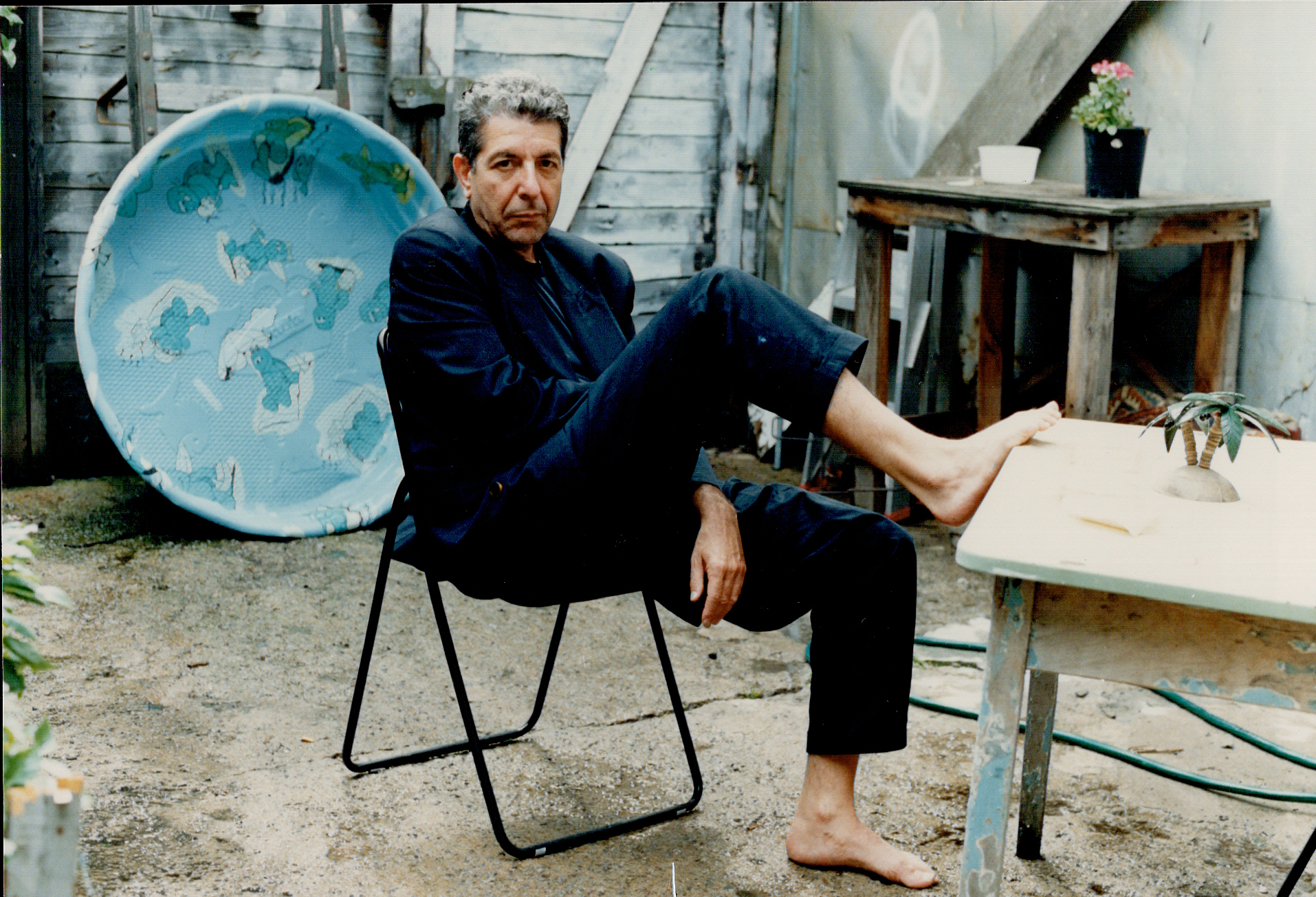The first time I heard the Leonard Cohen song “First We Take Manhattan” it was the R.E.M. version, on a tribute album. I had at that time a relationship with Leonard-Cohen-the-entity that I suspect a lot of people of my age shared, which is to say that I felt myself particularly, maybe even uniquely, attached to Leonard Cohen while only having heard a handful of his songs, i.e. the ones on The Best of Leonard Cohen tape with the yellow cover and a picture of him, dressed in black, staring moodily out while not making eye contact with the viewer. Also “Everybody Knows,” because it was in both Pump Up The Volume and Exotica. Beyond that, darkness.
It is dangerous to try to fully reconstruct the reactions of a past self, but what I remember is that I liked the song—it was portentous, it was dark, it felt accurate about how menacing and fucked up the world was—but I wasn’t fully convinced by the R.E.M. version. I was the real estate buyer charmed by a house’s good bones, dubious about the carpeting. So I saved my money and bought the Leonard Cohen album on which the song appeared and discovered that, actually, I hated the Leonard Cohen version. I thought it sucked. Some of that was just that it was the mid-’90s and I was too stupid to know that synthesizers were awesome. But the part I hated most was the chorus, where a peppy woman’s voice breaks through to tell us that she loves our body, our spirit, and our clothes. She follows up by telling us, still going full Flashdance, about having been part of the line they’re moving through the station, an impossibly messed-up image. I couldn’t handle it. I could believe that love for somebody’s body and spirit had a place in this landscape of existential struggle; I couldn’t wrap my head around the clothes.
“The constant occupation of a sane mind is to choose, establish, and maintain frames of reference for the things of its experience; as the high value placed on artistic unity attests, one of the attractions of art is that it offers a degree of holiday from that occupation,” Stephen Booth wrote in “On The Value Of Hamlet,” which seems like as good a way as any of expressing why “First We Take Manhattan” drove me crazy. That artistic unity was what I wanted, but wasn’t given. The pieces of the song didn’t feel like they fit together in my head; the way that line was written and the way it sounded felt like it belonged to a completely different song in a completely different genre.
There’s nothing particularly startling about the idea of the creator of a work of art deliberately injecting into it a foreign element in order to crack the glossy surface. Jane Austen (in a quote I only know from Lionel Trilling’s essay): “The work [in this case, Pride and Prejudice] is rather too light, and bright, and sparkling; it wants to be stretched out here and there with a long chapter of sense, if it could be had; if not, of solemn specious nonsense, about something unconnected with the story; an essay on writing, a critique on Walter Scott, or the history of Buonaparté.” This director’s cut of Pride and Prejudice does not, sadly, exist. But Tristram Shandy does actually have its black page, Moby Dick its whale facts, Brecht his Verfremdungseffekt. In the Waylon Jennings song “If Ole Hank Could Only See Us Now,” the ending skitters off into the sounds of a skipping record. Like the hip-hop skit, which became so entrenched that when it started receding people wrote articles about it, some of these devices become their own kind of formal expectation. When the singer interrupts “You Never Even Called Me By My Name” to start talking about what the song is missing to make it "the perfect country and western song," it doesn’t feel like an interruption—it’s normal in the context of a jokey country music song.
Some of these interruptions work great, while some work less great, and, inevitably, some of the greatness depends on what you want the art to do. Family legend has the painter my grandmother brought in to paint the walls of her apartment telling her, pleased with himself, that he fixed the crack in the painting hanging on her wall.
The thing about “First We Take Manhattan,” though, is that the part that I find disruptive is not obviously foreign to the rest of the song. It’s like the difficulties-of-being-a-woman speech in Barbie, a movie which I mostly enjoyed except for the Rhea Perlman parts and also that speech. I hated that speech despite (or possibly because of) having, at various points in my life, delivered versions of it. The movie was so beautiful in so many ways—the artificial campfires, the snowmobile! So much thought and care splashing lavishly about, and then, bam, the viewer hits the speech, so flat and lifeless, so embarrassing.
The difficulty of being a person watching a movie or listening to an album or reading a book and thinking something is mostly brilliant, but that one part of it is dumb and bad, is that I put myself in this weird position where I believe both that the person who generated this work of art is a genius, capable of doing something that I couldn’t do in a million years, but also that they are equipped with a massive blind spot that allows me, the casual viewer, to see where they went wrong. A weird position, but not an inherently paradoxical one; it’s probably true at least some of the time. If the measure of a work of art is its impact on a particular viewer, it becomes true by definition. And the thought of experiencing art without that prickly bedrock sense of potential equality with the creator of the piece seems actually kind of upsetting. Even when I am completely enthralled by what I’m witnessing, I arrive at that state by virtue of being convinced by what’s in front of me to surrender my critical impulses.
Some things that are mostly good just have dumb parts, for sure. But sometimes I can’t let go of my belief that there must be a purpose to the gaps between my imagined fully immersive experience and what the actual art object is, like with Barbie, or “First We Take Manhattan,” or the part of the Taylor Swift song “Gorgeous” where she says, forcefully, YEUGH, after singing about stumbling back home to her cats. I don’t like those parts; I wish they were not there. And yet I cannot reconcile myself to the idea that their presence is just a fuck-up on the part of the creator. Sometimes it feels closer to a deliberate choice to disfigure the experience than a simple error of judgment. Sometimes it hovers, maddeningly, between the two poles. It feels, a little bit, like having something stuck in your teeth.
In works where the surface is clearly being willfully disturbed, like Tristram Shandy or the spoken-word interludes in the Frank Ocean album Blonde, the discordances crack open what I’m reading or listening to, remind me that this object I’m absorbing is not just an impenetrable spaceship taking me to Art Land but a series of conscious creative choices by a human being. When I treat the parts of “First We Take Manhattan” that I don’t like as if they’re similarly deliberate, whether they are or not, it gives me a way to access the song that I wouldn’t have if I ignored them. That seems like a good thing.
But this same impulse can also take on a slightly crackpot quality—a National Treasure–style hunt for the “true meaning” of a work, a way of looking at whoever created what I’m listening to or looking at that reminds me of nothing so much as my religious childhood, where I believed that everything that happened was a riddle to be solved. The manic quest for true understanding doesn’t seem any more compatible with art appreciation than just saying this part sucks and moving on.
Once, when I was a dopey college student, I got a chance to go see the Documenta art show with a group of similarly dopey college students. There was art everywhere and a lot of it was art chosen precisely not to be immediately recognizable as art and by the time we were ready to go we had completely lost track of which aspects of the landscape were there through historical accident and which were there deliberately to fuck us up. My frames of reference were long gone. I stared uncertainly at a weed growing in an abandoned section of train tracks wondering if it was meant to be telling me something about the world.






